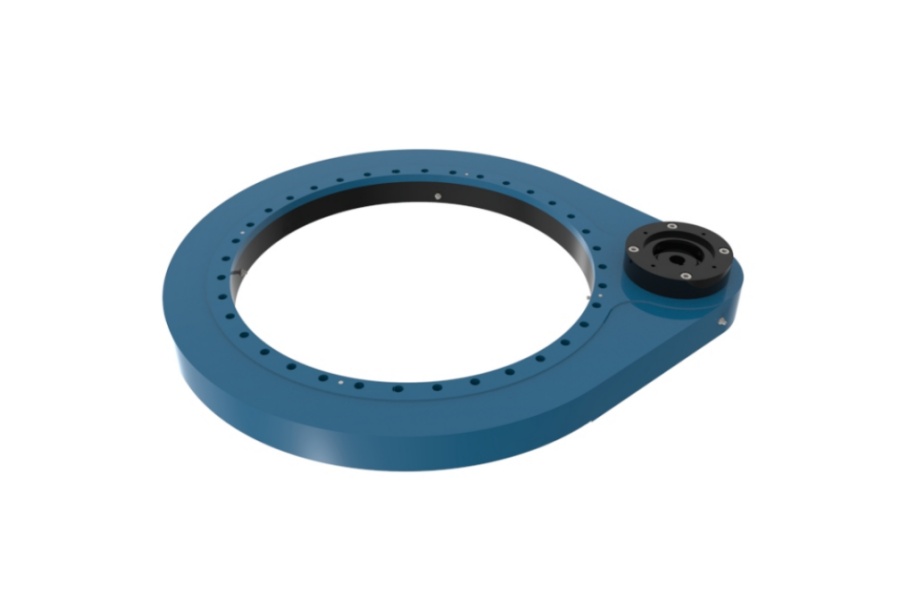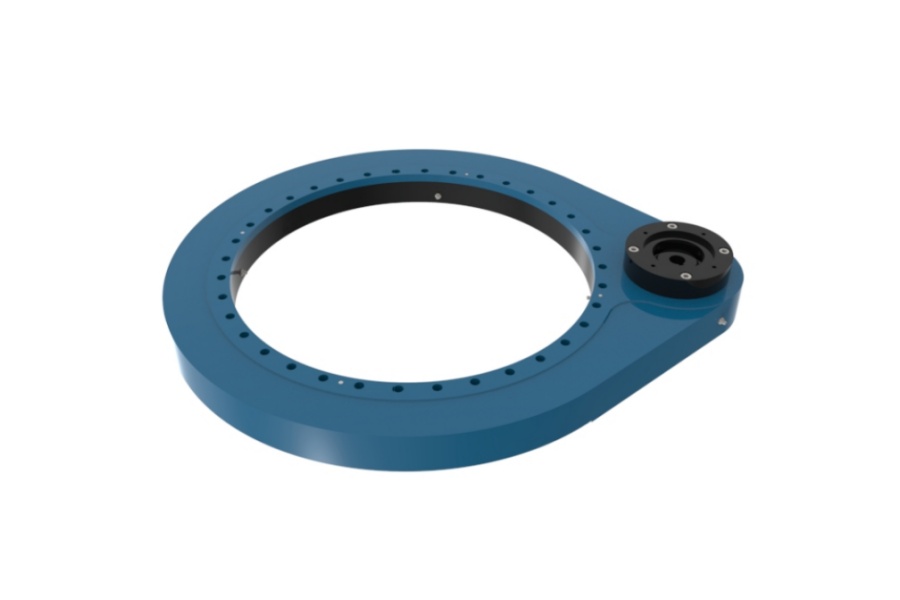
Decoding IP Ratings What Those Two Numbers Mean on Spur Gear Slew Drives
What is Spur Gear Slew Drive
Spur Gear Slew Drive is an integrated power transmission system combining a high-capacity slewing bearing, a compact yet robust gearbox (featuring straight-cut spur gears), and frequently an electric or hydraulic motor into a single, pre-assembled unit. It functions as a complete rotational drive solution, designed to provide high torque output at low rotational speeds. The spur gear teeth, typically cut directly onto the inner or outer ring of the slewing bearing, mesh with a pinion gear driven by the motor via the integral gearbox. This design efficiently converts motor input into powerful rotational force to turn heavy loads. Spur gear slew drives are renowned for their mechanical simplicity, high load-bearing capacity (axial, radial, and moment loads), excellent torque transmission, and straightforward installation, making them fundamental components in machinery requiring precise, powerful, and reliable slewing motion.

The Meaning Behind the Two-Digit IP Rating
The IP rating, signifying "Ingress Protection," is an international standard (IEC 60529) defining the effectiveness of an electrical enclosure's sealing against foreign bodies and moisture. For spur gear slew drives, this rating is critical as it directly indicates the drive's resilience to environmental contaminants like dust, dirt, sand, and water – common adversaries in industrial, mobile, and outdoor applications. The rating is always expressed as "IP" followed by two digits (e.g., IP65, IP67). Each digit has a specific, standardized meaning:
First Digit (Protection against Solid Objects): This digit ranges from 0 to 6 and defines the level of protection against the intrusion of solid foreign bodies, including tools, debris, and crucially, human body parts like fingers or hands.
No special protection.
Protection against solid objects greater than 50mm in diameter (e.g., accidental touch by hands).
Protection against solid objects greater than 12.5mm in diameter (e.g., fingers).
Protection against solid objects greater than 2.5mm in diameter (e.g., tools, thick wires).
Protection against solid objects greater than 1.0mm in diameter (e.g., most wires, small tools, large insects).
Dust Protected. Limited ingress of dust permitted (not harmful quantity). Full protection against contact with live or moving parts inside the enclosure by tools or wires. Prevents contact by human hands. Crucially prevents significant dust accumulation that could harm internal gears and bearings.
Dust Tight. No ingress of dust; complete protection against contact. Highest level of solid particle protection. Essential for extremely dusty environments like mining, deserts, or heavy construction.
Second Digit (Protection against Liquids): This digit ranges from 0 to 9K and defines the level of protection against the harmful ingress of water from various angles and pressures. Higher numbers indicate greater water resistance.
No protection.
Protection against vertically falling drops of water (e.g., condensation).
Protection against vertically falling water drops when enclosure tilted up to 15 degrees.
Protection against spraying water at angles up to 60 degrees from vertical.
Protection against splashing water from any direction.
Protection against water jets. Water projected by a nozzle (6.3mm) against enclosure from any direction shall have no harmful effects. Suitable for exposure to rain, washdowns, or seawater spray.
Protection against powerful water jets. Water projected in powerful jets (12.5mm nozzle) against the enclosure from any direction shall have no harmful effects. Suitable for harsher marine environments or high-pressure washdowns.
Protection against powerful water jets with increased pressure (specifically defined test). Common for heavy-duty industrial or agricultural equipment.
Protection against temporary immersion. Ingress of water in harmful quantity shall not be possible when the enclosure is immersed in water under defined conditions of pressure and time (up to 1m depth for 30 minutes). Suitable for accidental submersion or heavy flooding.
Protection against continuous immersion. The equipment is suitable for continuous submersion in water under conditions specified by the manufacturer (usually deeper than 1m and for longer periods than IP67). Typically specified for permanently submerged applications.
Protection against close-range high-pressure, high-temperature spray downs. Specific to road vehicles, especially for under-chassis cleaning.
Why it Matters: Choosing a spur gear slew drive with the correct IP rating is paramount. An insufficient rating can lead to:
Premature Wear: Dust and grit ingress act as abrasives, rapidly wearing down spur gear teeth, bearing raceways, and seals.
Corrosion: Water ingress causes internal corrosion of gears, bearings, and housing components.
Lubricant Contamination: Water and dirt contaminate the grease, degrading its lubricating properties and accelerating component failure.
Seal Failure: Seals can deteriorate quickly if exposed to contaminants beyond their design rating.
Catastrophic Failure: Ultimately, environmental ingress can lead to seized gears, bearing lockup, or complete drive failure, causing costly downtime and repairs.
Essential Characteristics of Spur Gear Slew Drives
Spur gear slew drives offer a distinct set of advantages derived from their integrated design and spur gear geometry:
High Torque Density: Delivers substantial output torque relative to its compact size, enabling the rotation of heavy loads with smaller drive units.
Robustness & Simplicity: Spur gears are mechanically straightforward, robust, and relatively easy to manufacture and inspect, contributing to overall drive reliability. The integrated design reduces the number of external components.
High Load Capacity: The integrated slewing bearing is engineered to handle significant combined axial, radial, and moment loads directly at the point of rotation.
Efficiency: Spur gears offer good mechanical efficiency, especially at lower speeds, minimizing power loss within the drive system.
Precise Positioning & Backdrive Resistance: The high friction inherent in spur gear systems (compared to worm gears) provides excellent resistance to backdriving, holding loads securely in position without needing a brake in many applications. Offers good positioning repeatability.
Integrated Design: Combines bearing, gearing, and mounting structure into one unit, simplifying machine design, installation, and maintenance.
Versatile Mounting: Designed with robust housings featuring multiple mounting options for flexible integration into machinery structures.
Motor Compatibility: Can be readily coupled with various electric motors (AC, DC, servo) or hydraulic motors to suit application power sources and control requirements.
Durability: Manufactured from high-strength, hardened steels (e.g., 42CrMo4, 20MnCr5) and equipped with quality seals and lubricants for long service life under demanding conditions.
Diverse Applications of Spur Gear Slew Drives
The combination of high torque, robust construction, and precise motion control makes spur gear slew drives indispensable across numerous sectors:
Solar Tracking: Precisely rotating solar panels (PV and CSP) to follow the sun's path throughout the day, maximizing energy capture. Requires high environmental protection (IP65/IP67 minimum).
Wind Energy: Adjusting the pitch angle of wind turbine blades for optimal power generation and storm protection. Demands high reliability and robustness.
Construction Equipment: Powering the rotation of excavator upper structures, crane booms, concrete pump booms, and drilling rig turntables. Needs high load capacity and impact resistance.
Material Handling: Rotating the booms and turrets of reach stackers, container handlers, forklifts, and automated storage/retrieval systems.
Industrial Automation: Driving heavy-duty rotary tables, welding positioners, pallet changers, indexing machinery, and large robotic arms in manufacturing.
Medical & Imaging: Positioning heavy medical diagnostic and treatment equipment like CT scanners, LINACs (radiation therapy), and MRI components.
Defense & Aerospace: Rotating radar antennae, missile launchers, gun turrets, and satellite communication dishes. Requires high precision and reliability.
Agriculture: Powering the rotation of large irrigation systems (center pivots, lateral moves) and heavy agricultural machinery components.
Recreation: Driving the rotation of Ferris wheels, observation decks, and large stage equipment.
Factors Influencing Spur Gear Slew Drive Price
The cost of a spur gear slew drive is determined by a complex interplay of engineering specifications, materials, manufacturing processes, and market factors:
Size & Torque Capacity: Larger diameter slew drives and those designed for higher output torque inherently require more material, larger bearings, and heavier-duty gearing, significantly increasing cost.
Load Requirements: The magnitude of axial, radial, and moment loads the integrated slewing bearing must handle dictates bearing size, type (e.g., single-row ball, cross roller, three-row roller), and material grade, directly impacting price.
Gear Specifications: Module/size of the spur gear and pinion, gear quality (precision milling vs. grinding), material grade (e.g., 20MnCr5 carburized), hardening depth, and surface finish all contribute to cost. Ground gears offer superior performance but are more expensive.
Protection Level (IP Rating): Achieving higher IP ratings (especially IP67, IP68, IP69K) requires significantly more sophisticated sealing systems (multiple high-quality lip seals, special seal materials like FKM/Viton, precise machining of sealing surfaces), complex housing designs, and rigorous testing, adding substantial cost.
Housing Material & Construction: Cast iron or ductile iron housings are common and robust. Special materials (stainless steel) or complex casting/machining for high IP ratings or corrosion resistance increase cost.
Integrated Components: The inclusion and specification of the motor (type, power, efficiency class, brand), brakes, encoders/resolvers for positioning feedback, and sensors (temperature, vibration) add significant cost. Hydraulic motor options also vary in price.
Gearbox Ratio & Efficiency: The required reduction ratio and the engineering focus on achieving high gearbox efficiency influence design complexity and cost.
Material Quality: The grade and sourcing quality of steel for gears, bearings, shafts, and housing (e.g., certified 42CrMo4 vs. standard 50Mn) affect durability and price.
Manufacturing Precision & Quality Control: Tighter tolerances for gear meshing, bearing preload, seal fits, and overall assembly require advanced machinery, skilled labor, and extensive quality control (e.g., gear testing, bearing clearance checks, run-in testing), increasing manufacturing costs.
Certifications & Testing: Meeting specific industry standards (ISO, AGMA, DNV-GL) or customer-mandated certifications, and performing additional testing (load testing, life testing, salt spray testing), adds overhead.
Customization Level: Fully customized designs (non-standard sizes, unique mounting flanges, special coatings, specific motor interfaces) are considerably more expensive than standard catalog products. Modifications to standard units also add cost.
Quantity: Economies of scale apply; larger order quantities typically reduce the unit price.
Supplier Expertise & Reputation: Established manufacturers with proven reliability, technical support, and warranty terms often command a premium.
Market Dynamics & Raw Materials: Fluctuations in global steel, copper (for motors), and energy prices directly influence final product pricing.
Supplier of Spur Gear Slew Drive
LYRADRIVE stands as a leading global designer and manufacturer of high-performance spur gear slew drives and integrated drive systems. With over 15 years of specialized engineering expertise, LYRADRIVE is committed to delivering robust, reliable, and application-optimized solutions for the most demanding industrial, energy, and mobile machinery sectors. Their comprehensive product range encompasses standard and fully customized spur gear slew drives engineered to meet precise torque, load, and stringent environmental protection requirements, including high IP ratings critical for solar, marine, and harsh outdoor applications. Utilizing premium materials, advanced manufacturing techniques, and rigorous quality control aligned with ISO 9001 standards, LYRADRIVE ensures exceptional durability and longevity. They provide unparalleled technical support from initial design consultation through installation and maintenance, partnering with clients to enhance machine performance and minimize operational downtime. LYRADRIVE's dedication to innovation, quality, and customer service makes them a trusted partner for critical rotational drive needs worldwide.



